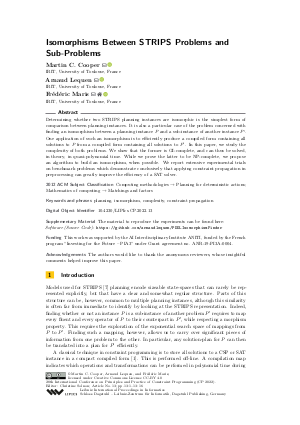Isomorphisms Between STRIPS Problems and Sub-Problems
Authors
Martin C. Cooper  ,
Arnaud Lequen
,
Arnaud Lequen  ,
Frédéric Maris
,
Frédéric Maris 
-
Part of:
Volume:
28th International Conference on Principles and Practice of Constraint Programming (CP 2022)
Part of: Series: Leibniz International Proceedings in Informatics (LIPIcs)
Part of: Conference: International Conference on Principles and Practice of Constraint Programming (CP) - License:
 Creative Commons Attribution 4.0 International license
Creative Commons Attribution 4.0 International license
- Publication Date: 2022-07-23
File

PDF
LIPIcs.CP.2022.13.pdf
- Filesize: 0.82 MB
- 16 pages
Document Identifiers
Subject Classification
ACM Subject Classification
- Computing methodologies → Planning for deterministic actions
- Mathematics of computing → Matchings and factors
Keywords
- planning
- isomorphism
- complexity
- constraint propagation
Metrics
- Access Statistics
-
Total Accesses (updated on a weekly basis)
0Document
0Metadata
Abstract
Determining whether two STRIPS planning instances are isomorphic is the simplest form of comparison between planning instances. It is also a particular case of the problem concerned with finding an isomorphism between a planning instance P and a sub-instance of another instance P'. One application of such an isomorphism is to efficiently produce a compiled form containing all solutions to P from a compiled form containing all solutions to P'. In this paper, we study the complexity of both problems. We show that the former is GI-complete, and can thus be solved, in theory, in quasi-polynomial time. While we prove the latter to be NP-complete, we propose an algorithm to build an isomorphism, when possible. We report extensive experimental trials on benchmark problems which demonstrate conclusively that applying constraint propagation in preprocessing can greatly improve the efficiency of a SAT solver.
Cite As Get BibTex
Martin C. Cooper, Arnaud Lequen, and Frédéric Maris. Isomorphisms Between STRIPS Problems and Sub-Problems. In 28th International Conference on Principles and Practice of Constraint Programming (CP 2022). Leibniz International Proceedings in Informatics (LIPIcs), Volume 235, pp. 13:1-13:16, Schloss Dagstuhl – Leibniz-Zentrum für Informatik (2022)
https://doi.org/10.4230/LIPIcs.CP.2022.13
BibTex
@InProceedings{cooper_et_al:LIPIcs.CP.2022.13,
author = {Cooper, Martin C. and Lequen, Arnaud and Maris, Fr\'{e}d\'{e}ric},
title = {{Isomorphisms Between STRIPS Problems and Sub-Problems}},
booktitle = {28th International Conference on Principles and Practice of Constraint Programming (CP 2022)},
pages = {13:1--13:16},
series = {Leibniz International Proceedings in Informatics (LIPIcs)},
ISBN = {978-3-95977-240-2},
ISSN = {1868-8969},
year = {2022},
volume = {235},
editor = {Solnon, Christine},
publisher = {Schloss Dagstuhl -- Leibniz-Zentrum f{\"u}r Informatik},
address = {Dagstuhl, Germany},
URL = {https://drops.dagstuhl.de/entities/document/10.4230/LIPIcs.CP.2022.13},
URN = {urn:nbn:de:0030-drops-166426},
doi = {10.4230/LIPIcs.CP.2022.13},
annote = {Keywords: planning, isomorphism, complexity, constraint propagation}
}
Author Details
Funding
This work was supported by the AI Interdisciplinary Institute ANITI, funded by the French program "Investing for the Future – PIA3" under Grant agreement no. ANR-19-PI3A-0004.
Acknowledgements
The authors would like to thank the anonymous reviewers, whose insightful comments helped improve this paper.
Supplementary Materials
- The material to reproduce the experiments can be found here:
- Software (Source Code) https://github.com/arnaudlequen/PDDLIsomorphismFinder
References
- Jérôme Amilhastre, Hélène Fargier, and Pierre Marquis. Consistency restoration and explanations in dynamic csps application to configuration. Artif. Intell., 135(1-2):199-234, 2002. URL: https://doi.org/10.1016/S0004-3702(01)00162-X.
-
László Babai. Group, graphs, algorithms: the graph isomorphism problem. In Proceedings of the International Congress of Mathematicians, pages 3319-3336. World Scientific, 2018.

- Djamila Baroudi, Maël Valais, and Frédéric Maris. Touistplan. URL: https://github.com/touist/touistplan.
-
Tom Bylander. The computational complexity of propositional strips planning. Artificial Intelligence, 69(1-2):165-204, 1994.

- Stephen A. Cook. The complexity of theorem-proving procedures. In Michael A. Harrison, Ranan B. Banerji, and Jeffrey D. Ullman, editors, 3rd Annual ACM Symposium on Theory of Computing, pages 151-158. ACM, 1971. URL: https://doi.org/10.1145/800157.805047.
- Adnan Darwiche and Pierre Marquis. A knowledge compilation map. J. Artif. Intell. Res., 17:229-264, 2002. URL: https://doi.org/10.1613/jair.989.
- Richard Fikes and Nils J. Nilsson. STRIPS: A new approach to the application of theorem proving to problem solving. Artif. Intell., 2(3/4):189-208, 1971. URL: https://doi.org/10.1016/0004-3702(71)90010-5.
- Malte Helmert. Complexity results for standard benchmark domains in planning. Artificial Intelligence, 143(2):219-262, 2003. URL: https://doi.org/10.1016/S0004-3702(02)00364-8.
-
Henry A. Kautz and Bart Selman. Planning as satisfiability. In Bernd Neumann, editor, ECAI 92, pages 359-363. John Wiley and Sons, 1992.

- Songtuan Lin and Pascal Bercher. Change the world - how hard can that be? On the computational complexity of fixing planning models. In Zhi-Hua Zhou, editor, IJCAI-21, pages 4152-4159, August 2021. URL: https://doi.org/10.24963/ijcai.2021/571.
- Mao Luo, Chu-Min Li, Fan Xiao, Felip Manyà, and Zhipeng Lü. An effective learnt clause minimization approach for cdcl sat solvers. In IJCAI-17, pages 703-711, 2017. URL: https://doi.org/10.24963/ijcai.2017/98.
-
Alan K Mackworth. Consistency in networks of relations. Artificial intelligence, 8(1):99-118, 1977.

- Peter Nightingale, Özgür Akgün, Ian P. Gent, Christopher Jefferson, Ian Miguel, and Patrick Spracklen. Automatically improving constraint models in savile row. Artif. Intell., 251:35-61, 2017. URL: https://doi.org/10.1016/j.artint.2017.07.001.
-
Francesca Rossi, Peter Van Beek, and Toby Walsh. Handbook of Constraint Programming. Elsevier, 2006.

-
Viktor N Zemlyachenko, Nickolay M Korneenko, and Regina I Tyshkevich. Graph isomorphism problem. Journal of Soviet Mathematics, 29(4):1426-1481, 1985.

